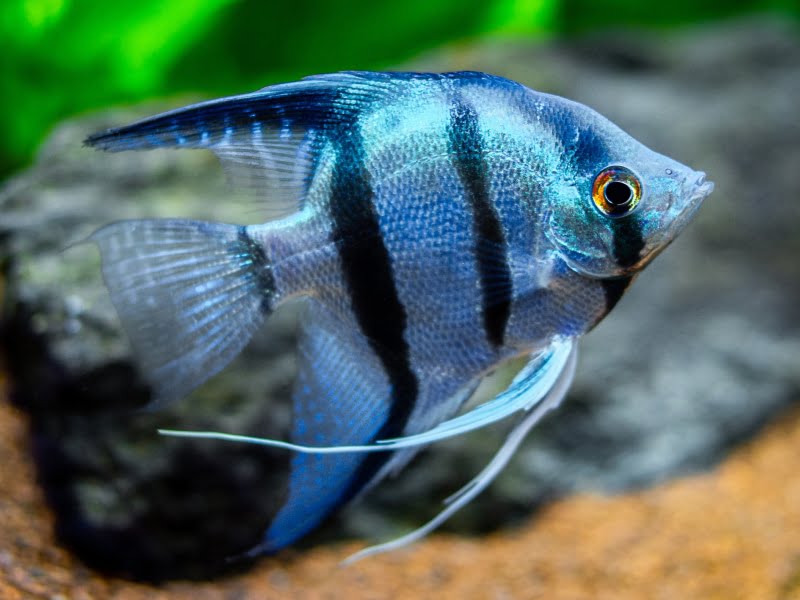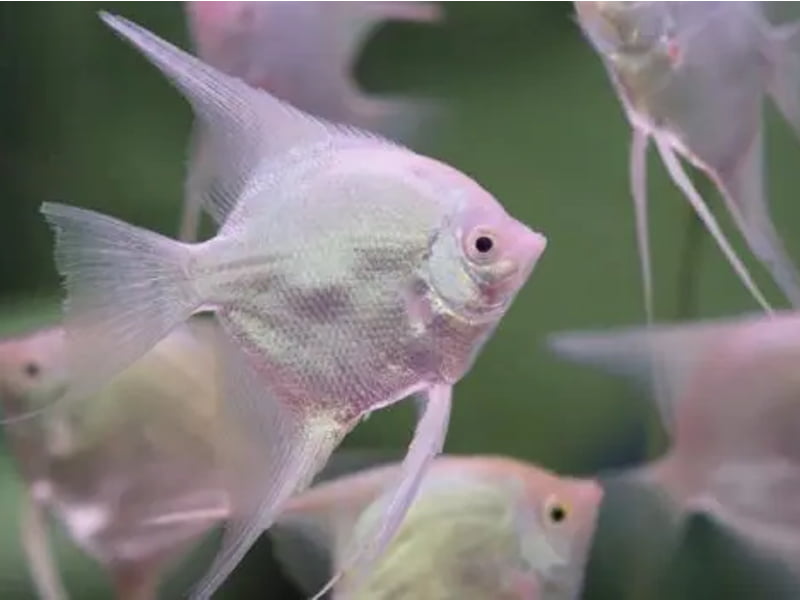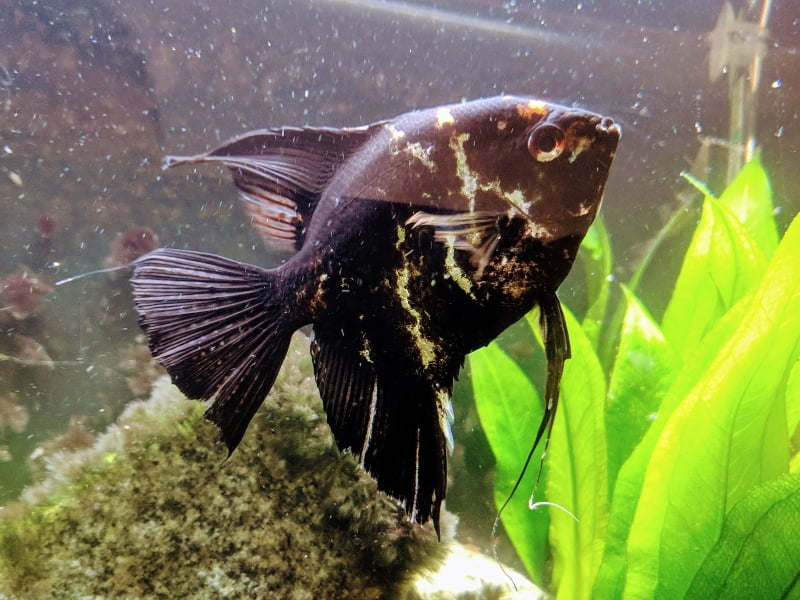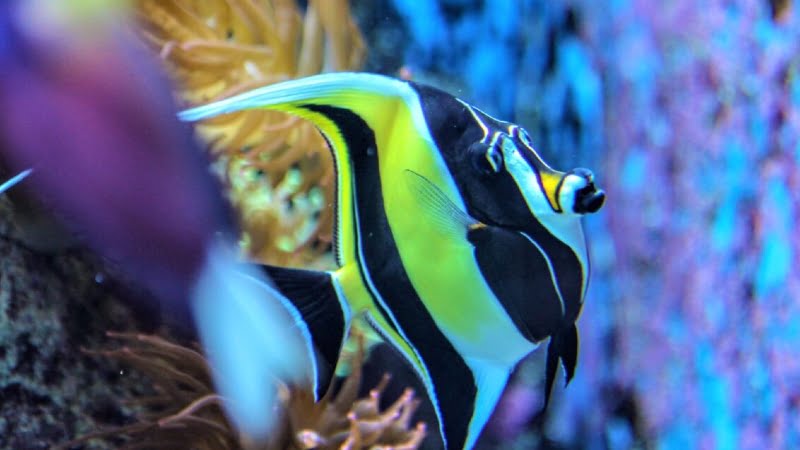Angelfish changing color may be a clear sign that indicates the health problems of your precious pets. Luckily, there are ways to treat the conditions and recover the original vibrant color that these large aquarium fish have. I will give you tips on how to detect the disease at an early stage, the factors that cause the loss of color, and how to treat the condition.
Related Articles
- Top 3 Features About Angelfish With Red Eyes
- Why Are Angelfish Eggs Turning White? 5 Best Ways To Avoid
Symptoms And Consequences Of Angelfish Changing Color
Since the change of color is easily detectable by checking with our own eyes, there is no need to use any special tools to recognize the symptoms of decoloration. However, it’s important to keep in mind that it’s not always a bad thing when angelfish change color.
When an angelfish turns white and becomes paler, this is the sign of columnaris or mouth and fin rot. Whenever angelfish turn white, it’s 100% certain that the decoloration is harmful. We can directly visualize white spots over the fins and on the mouth of the fish. If we don’t treat this condition, the rot spot can spread and damage the entire fins and eat away the meat of the mouth. Premature death is inevitable in this case.
On the contrary, when your angelfish slowly becomes bluer, yellower, or more black, this can indicate that the dermis, which controls the vibrancy of color, is working at full force, making your fish more colorful and attractive.

7 Factors That Lead To Angelfish Changing Color
Talking about the negative side of angelfish changes in color, there are 7 major reasons this condition occurs with your fish. Get to know them below, and you will learn how to confront the situation and save your pets, if necessary.
Old Age
When your fish reach the adult phase, their color may become stronger and more vibrant. This is a good sign. When you purchase a young angelfish, its color hasn’t developed to its true potential yet.
However, if you buy a fish that has already reached the adult phase from the store, it’s normal that the vibrancy of the scale’s color becomes more muted after some months or years. Due to old age, most fish will become paler and less attractive in terms of color. There isn’t much we can do at this phase except for keeping up with the protein-rich diet and good water quality. The color will be improved slightly.
High Stress During An Extended Period Of Time
If you keep your angelfish with incompatible tank mates like African cichlids or jaguar cichlids, your angelfish will become stressed due to being bullied by these more aggressive breeds. Furthermore, if we don’t keep an eye on the aggressions in the tank, a small behavior of harassment like chasing can escalate to fin nipping or bitting.
Being exposed to such a stressful environment for a long time will cause your angelfish to lose their naturally spectacular colors. Instead, they will look paler, and the colors are muted.
Diet And Nutrition
Poor diets could cause your fish to lose color. Some argue against these, but experts agree that they contain all the nutrition that angelfish require to thrive. But, a typically poor diet and deficient nutrients could cause your angelfish’s color to fade.
However, certain fish that are fed well have a similar issue. It’s just a matter of experimenting until you discover a diet system that permits the fish to flourish in colors.

Low-Quality Gene From Crossbreeding
Many fish owners want to crossbreed different breeds of cichlids to create a new mixture of color or physical aspects. That sounds fun and logical, but many don’t know how to do it, and the consequences that crossbreeding might bring.
In most cases, the children of crossbreeding are quite weak and suffer some mutation. Their genes aren’t strong enough. Thus they are more exposed to catching diseases. That’s why their coloration isn’t as impressive, and they can lose it gradually.
Poor Water Quality
It’s obvious that the living environment of the fish affects their coloration. If your tank is full of algae and the filter doesn’t work well, the water parameters may be off and affect your fish’s health and life quality. Therefore, angelfish changing color happens.
Bacteria live and thrive in such conditions, and the fish can get stressed out in an unideal living condition. Therefore, bringing the water parameters back to normal is logical in this case.
Light Conditions

Angelfish can react when they see changes in the light. There are instances when the angelfish stripes fade in dark rooms and then be restored to their original form when the lights turn back on. There hasn’t been any scientific evidence that explains how this affects angelfish, but I have observed the fish, and there is a slight change in the intensity of color.
Sudden Changes In Water Parameters And Quality
Cleaning the tank and performing a weekly change of water is what aquarists do to maintain the living conditions of the fish. However, sometimes we get too excited and remove too much water from the tank to replace it with a new one. And maybe, this fresh water isn’t dechlorinated well enough and intoxicates the fish.
Anything can happen, and these sudden changes in water parameters will cause the fish to become moody, affecting their color. They will become more muted in color.
How To Treat Color Change In Angelfish
Pairing the angelfish with compatible tank mates, offering them foods rich in protein like brine shrimps or flake foods, and keeping the water clean can ensure that the decoloration doesn’t happen or subsides. Keeping the water parameters at a normal state always helps.
In general, my advice is that we don’t neglect the fish and keep everything normal and simple. Feeding the fish too much color-enhancing food can dye the water and make it dirty, so it’s not good either. Take your time with the fish, and they will surely recover their original vibrant and metallic colors.
Video: Do Angelfish Change Color? ~ Why Do Angelfish Change Color
FAQs
Do angelfish change color?
Yes, angelfish can change color. But this is not a good sign since only sick angelfish become paler in color. To ensure that the color of the fish is always vibrant, maintaining an ideal environment, providing a sufficient diet with vitamins, and keeping the cohabitation peaceful are the standard requirements for good coloration.
Why is my black angelfish turning white?
Stress or ich are the most common reasons that cause a black angelfish to turn white. We can already avoid stress and ich by providing a clean aquarium for the fish and house angelfish with compatible tank mates. Thus, avoiding angelfish changing color.
How can you tell if an angelfish is stressed?
If fish are stressed, they tend to develop strange patterns of swimming. When your pet is swimming in an agitated manner without a clear direction or falling to the bottom of his tank, rubbing himself against the rocks or gravel, your angelfish may be going through a tough time.

Annette M. Chaney is an experienced marine biologist with over 20 years of experience as an aquarist and fishkeeper. She started her first aquarium at a young age, filling it with frogs and goldfish obtained from the ten-cent pet store.
Annette grew up caring for and breeding African Cichlids, which led to a hobby in high school that doubled as a profitable means. Attending Reed College gave her time to solidify herself as an accomplished aquarium caretaker with an eye for sales. After that, from 2009 – 2013, she studied at Roger Williams University – one of the most prestigious universities for Aquaculture and Aquarium in USA. She is the founder of AquariumCircle since 2010.
